ISSN ONLINE(2278-8875) PRINT (2320-3765)
ISSN ONLINE(2278-8875) PRINT (2320-3765)
Vipin Das P1, Emil Ninan Skariah2, TibinJoseph3, Sasidharan Sreedharan4, Chittesh V C1, SebinJoseph1, Vishnu J1
|
| Related article at Pubmed, Scholar Google |
Visit for more related articles at International Journal of Advanced Research in Electrical, Electronics and Instrumentation Engineering
The use of electrical energy increasing day by day, so we need more generation to meet the demand. Nowadays due to environmental and fuel cost constraints more and more renewable energy sources are introduced into the power system. Since renewable energy sources are both inexhaustible and non-polluting they are the key to a sustainable energy supply system. With the rapid growth of wind power generation, wind farms will affects the economic operation of power system. This paper presents a new approach for loadability enhancement in power system with wind energy sources, without violating the system constraints. Particle Swarm Optimization (PSO) algorithm is used in this paper for optimization purpose. The proposed method is simulated on an IEEE 14 bus standard test system. The test system for the proposed method is modelled and simulated using MATLAB/PSAT.
Keywords |
| PSO, PSAT, MATLAB, IEEE14 Bus, Optimization |
INTRODUCTION |
| Electrical energy is the vital ingredient for the day to day functioning of modern societies. It is required for functioning of the various sectors of society like information and communication technology, transportation, lighting, food processing and wide variety of industrial processes. To meet the future energy demand we need more generation sources with adequate capacity. Renewable energy sources are better solution for the future energy demand. Many countries are placing enormous pressure on entire energy industry to reduce carbon emission and thereby reducing greenhouse effect. Combustion of fossil fuels, coal, oils is the main cause of greenhouse gases. All these effects can be avoided using renewable energy sources. Wind, Solar Photovoltaic, Fuel cells are examples of renewable energy sources. Among these wind and solar photovoltaic are most commonly used, wind energy is the most promising source of clean and cheap energy. According to the wind energy council report the total worldwide installation of wind farm is 31% in 2009 i.e., 157.9GW. It is predicted that by the end of 2020 the total wind energy generation will be 1261GW. |
| The increasing environmental challenges forces the electric power utilities to modify their system operation routine to reduce carbon emission. Due to the intermittent nature of renewable energy, they bring a great challenge to power system optimization problems. However the integration and high penetration of distributed generations into the power system poses many issues that need to be addressed carefully. The variations in wind speed and unpredictable solar radiation causes the output powers from wind and photo voltaic systems to fluctuate considerably. With increased size and complexity of modern power system, there are chances of cascaded effect of oscillations from a small disturbance leading to complete system black out. In this paper an extended Optimal Power Flow (OPF) [1] is presented to research the effect of renewable energy sources on system loadability of power system. The IEEE 14 bus system is used to analyse the effect of connected wind farm on the power system operation and verify the effectiveness of model and the validity of proposed algorithm . Integrating wind sources to the grid is a major problem in power sector facing today. |
| To mitigate this issue here a new control algorithm is proposed to increase the loading margin of typical power system. PSO is used as an optimization tool here [2]. The controller ensures that no stability constraints are violated. |
PROPOSED METHODOLOGY |
| The proposed methodology includes placing of DFIG based wind farm on the basis of Wind Farm Placement Index (WFPI)[3]. Designing of suitable algorithm include detailed study of power system and wind energy conversion system [4]. Fig. 1 shows the block diagram of the proposed method. |
 |
PROBLEM FORMULATION |
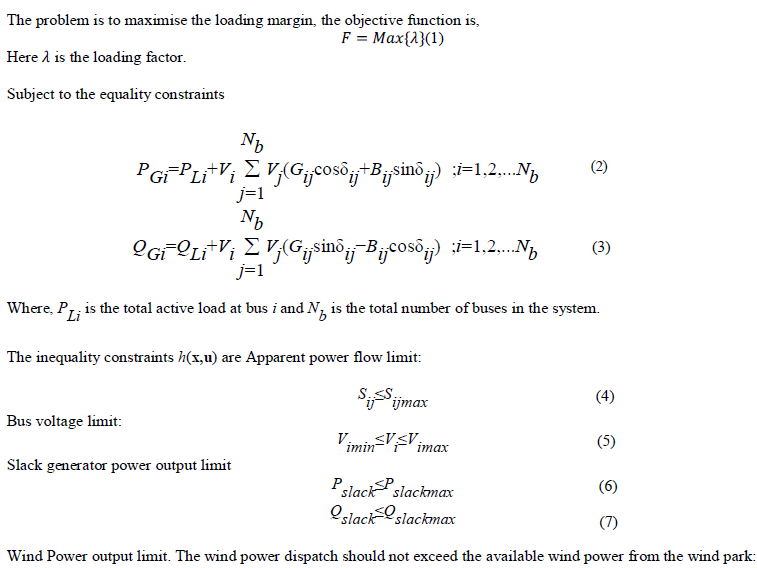 |
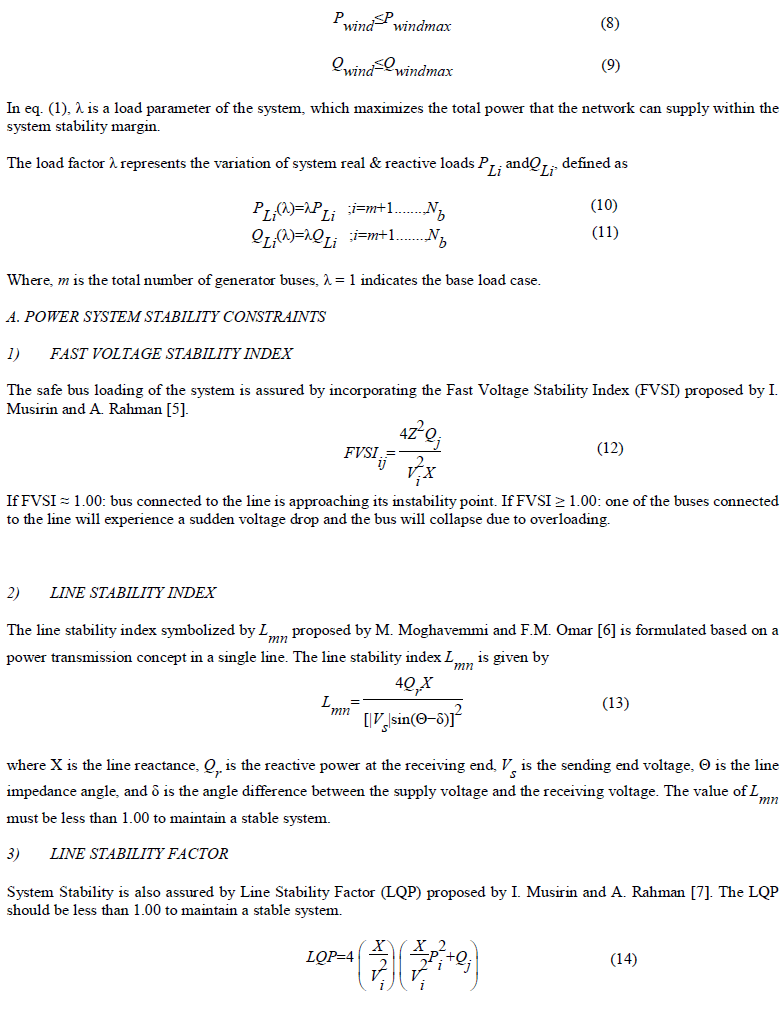 |
| LQP assure that at no level of bus loading the line is overloaded. |
SIMULATION RESULTS & DISCUSSION |
| A. System Description |
| The proposed method is simulated on an IEEE 14 bus test system. Bus code diagram of IEEE-14 bus test system is depicted in Fig 2. In IEEE-14 bus system, there are five synchronous generators among which three of them are synchronous compensator. There are twenty branches and fourteen buses with eleven loads totalling 362.5 MW and 108.5 Mvar. DFIG based wind generator is connected to the system [8]. The analysis was done using MATLAB based toolbox PSAT developed by Dr. F. Milano. |
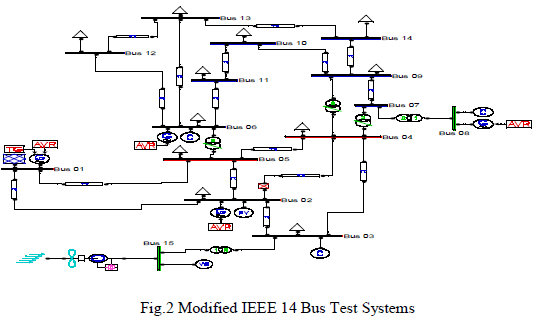 |
| B. Results & Analysis |
| For the analysis of the system wind source is placed at bus number 3. The wind farm is connected to the third bus by WFPI proposed by Sasidharan et al[3]. The program was coded in PSAT/MATLAB integrated environment as suggested by Milano F (2005)[8].In the proposed system a wind farm consisting of 300 wind turbines and 600 MW is added to the bus number 3[3]. A new bus named bus 15 is added to the 14 bus system to incorporate the wind farm. |
| Voltage profile of each bus is shown below in fig 3. The figure given below shows that by adding the wind farm at bus 3 the voltage at each bus is within the limit. The voltages are limited to be within 0.90 pu and 1.1 pu. |
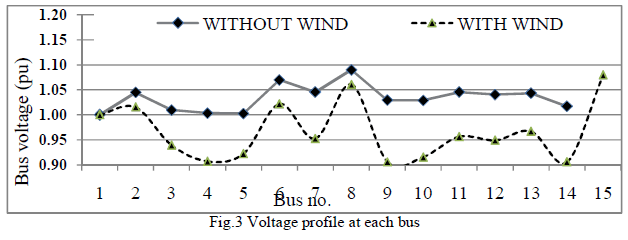 |
| Fig4 shows the generation at each buses. Bus 15 is the bus where wind is placed. Bus number 1 is the slack bus and maximum generation is contributed by the bus number 1. |
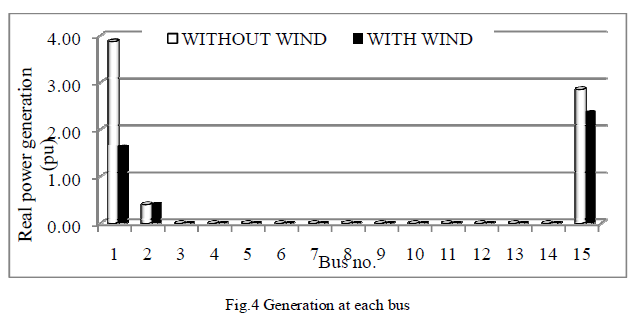 |
| Fig 5 shows the load at each bus. Maximum load is shared by the bus 3. From the figure it is clear that by adding wind to the system the loading capacity is increased. |
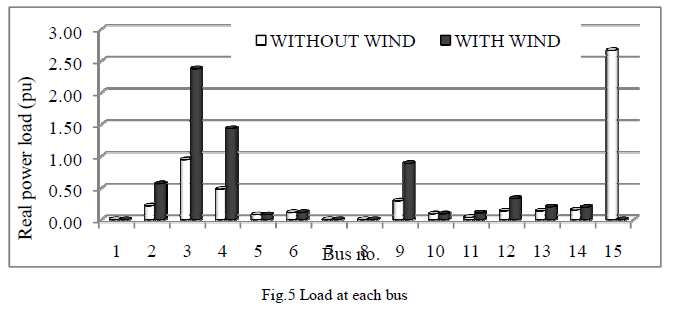 |
CONCLUSION |
| In this paper, a new methodology of optimal allocation of distributed energy resources has been proposed to maximize the loadability by taking into consideration the power system stability and security constraints. A PSO based algorithm has been used to obtain the minimize the system operating cost. The results are satisfactory when tested on IEEE 14- bus system. The results indicate that the proposed controller is working properly. From the results it is clear that loadability can be increased by penetrating wind to the system. Incorporation of stability constraints ensures the stability of the system in any loading condition. |
References |
|